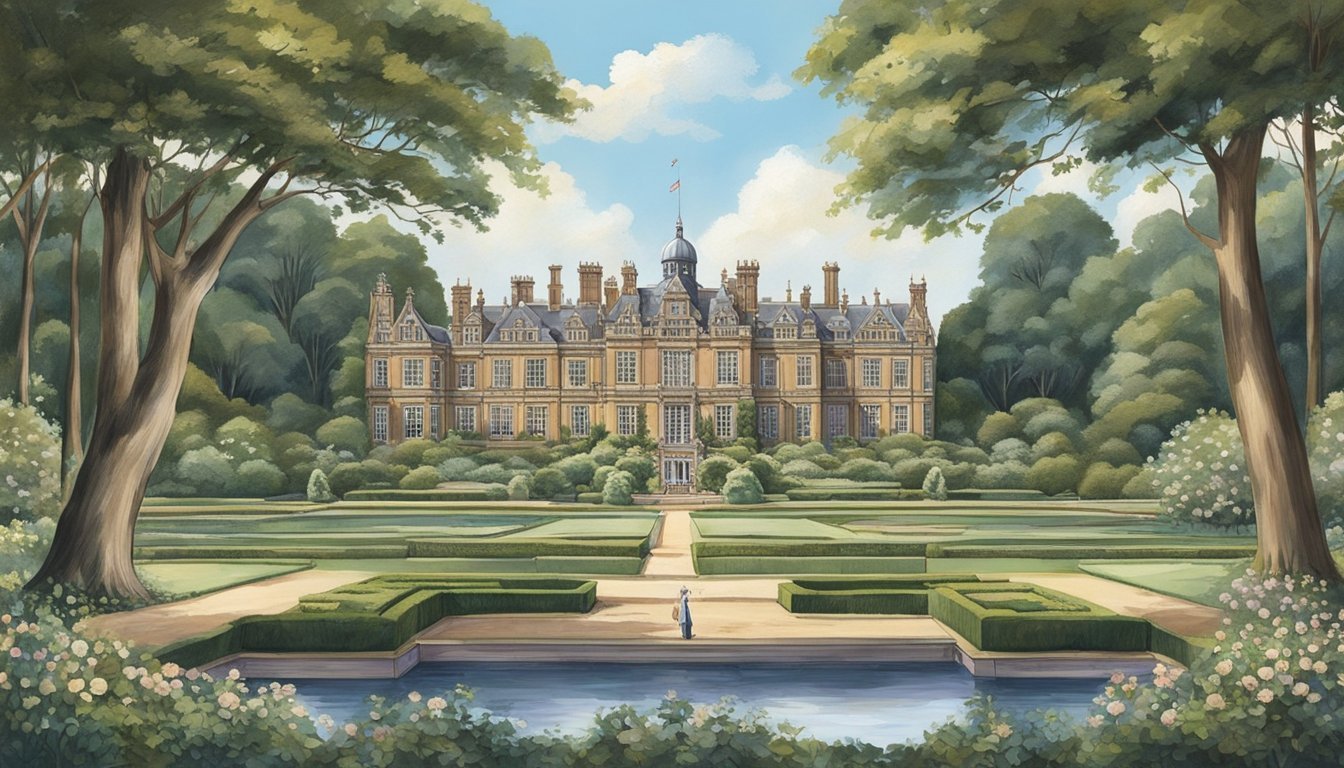Royal Struggles: The True Diana in 'Spencer'
A Raw Portrait of a Princess's Inner Turmoil
Pablo Larraín's film "Spencer" offers a fictionalized glimpse into Princess Diana's life during a pivotal Christmas holiday at Sandringham in 1991. The movie, starring Kristen Stewart as Diana, explores the royal's inner turmoil as she grapples with her crumbling marriage to Prince Charles and the stifling expectations of the Royal Family.
While "Spencer" takes creative liberties with historical events, it draws inspiration from real struggles Diana faced during her time with the monarchy. The film condenses these issues into a three-day period, heightening the emotional intensity and providing a focused lens through which to examine Diana's experiences.
Kristen Stewart's portrayal of Diana has garnered critical acclaim, capturing the princess's vulnerability and strength as she navigates the suffocating atmosphere of Sandringham. The movie serves as a character study, delving into Diana's psyche and her desire for freedom from royal constraints.
The Genesis of 'Spencer'
'Spencer' emerged as a unique take on the Princess Diana story, directed by Chilean filmmaker Pablo Larraín. Known for his unconventional biopics, Larraín brought a fresh perspective to the well-documented life of the People's Princess.
The film's screenplay was penned by Steven Knight, an acclaimed British writer. Knight crafted a narrative that focused on a specific three-day period during Christmas 1991 at the Queen's Sandringham estate.
Larraín and Knight chose to frame the story as a "fable from a true tragedy". This approach allowed them creative freedom to explore Diana's inner turmoil and the pressures she faced.
The filmmakers deliberately avoided a traditional biopic format. Instead, they opted for a more intimate portrayal that delved into Diana's psychological state during a pivotal moment in her life.
'Spencer' stands out among Diana biopics for its concentrated timeframe and surreal elements. It blends historical facts with imaginative interpretations of Diana's experiences, creating a unique cinematic portrait.
The project aimed to humanize Diana beyond her public image. It sought to present her struggles within the royal family and her journey towards self-realization in a new light.
Character Analysis: Kristen Stewart as Diana
Kristen Stewart's portrayal of Princess Diana in 'Spencer' showcases a transformative performance that delves into the complexities of the royal figure. Her embodiment of Diana's mannerisms and emotional turmoil offers a nuanced exploration of the princess's inner world.
Physical Transformation and Portrayal
Stewart underwent significant changes to capture Diana's essence. She adopted the princess's distinctive accent and replicated her posture and gestures with remarkable precision. The actress's physical resemblance was enhanced through carefully crafted costumes and hair styling, mirroring Diana's iconic looks from the early 1990s.
Stewart's attention to detail extended to subtle facial expressions and body language, effectively conveying Diana's emotional state. Her portrayal highlighted the princess's grace under pressure and her moments of vulnerability, creating a believable depiction of the public figure.
Psychological Depth of Diana's Character
The film explores Diana's psychological struggles, with Stewart delivering a performance that reveals the princess's inner turmoil. She portrays Diana's feelings of isolation within the royal family and her battle with bulimia with sensitivity and depth.
Stewart's interpretation emphasizes Diana's strength and resilience in the face of mounting pressures. The actress captures the princess's internal conflict between her public duties and personal desires, showcasing moments of rebellion and despair.
The performance brings to light Diana's complex relationships with the royal family members, particularly her strained marriage to Prince Charles.
Challenges in Depicting Princess Diana
Portraying such a well-known figure presented unique challenges for Stewart. The actress had to balance public perceptions of Diana with a fresh interpretation of her character. Stewart's approach aimed to humanize Diana beyond her public image, offering glimpses into her private thoughts and emotions.
The film's fictional nature allowed Stewart to explore aspects of Diana's personality that were less documented. This creative freedom enabled a more intimate portrayal, though it required careful consideration to maintain authenticity.
Stewart faced the task of depicting Diana's mental health struggles respectfully. Her performance navigated the fine line between dramatization and sensitivity, aiming to shed light on the pressures Diana faced without sensationalizing her difficulties.
Historical and Cultural Context
Princess Diana's impact on the British monarchy and society was profound. Her life and struggles within the royal family reflected broader cultural shifts and challenged traditional notions of royalty.
Princess Diana's Impact and Legacy
Diana transformed the public perception of the royal family. Her humanitarian efforts brought attention to important causes like AIDS and landmines. She connected with people on a personal level, earning the title "People's Princess."
Diana's fashion choices and public persona made her a global icon. Her openness about her struggles with mental health and eating disorders helped reduce stigma around these issues.
Even after her death, Diana's influence continues. Her sons William and Harry have carried on her charitable work and approach to royal duties.
The Royal Family's Public Persona
The royal family's image evolved significantly during Diana's time. Her arrival brought youthful energy and relatability to an institution often seen as outdated.
Diana's struggles highlighted tensions between tradition and modernity within the monarchy. Her public discussions of marital problems challenged the royal family's private nature.
Media scrutiny of the royals intensified, leading to both positive and negative consequences. The family had to adapt to changing public expectations and increased transparency.
Comparisons with Historical Figures
Diana's life drew parallels with other royal figures who faced challenges. Anne Boleyn, second wife of Henry VIII, similarly faced intense public scrutiny and royal pressures.
Like Diana, Marie Antoinette of France was a young woman thrust into a powerful royal role. Both became fashion icons and faced criticism for their perceived extravagance.
Princess Grace of Monaco, another commoner who married into royalty, shared Diana's struggle with media attention and the pressures of royal life.
Setting the Scene: Sandringham Estate
Sandringham Estate serves as the backdrop for the pivotal events in 'Spencer'. This royal retreat holds deep significance for the British monarchy and played a crucial role in Princess Diana's story.
The Significance of Sandringham
Sandringham Estate, located in Norfolk, England, has been a private residence of the British royal family since 1862. The 20,000-acre property traditionally hosts the royals' Christmas celebrations.
For Princess Diana, Sandringham held a unique connection. Her childhood home, Park House, was situated on the estate grounds. This proximity added layers of complexity to her experiences there as a royal.
The estate's isolation and grandeur intensified the pressures of royal protocol during holiday gatherings. Diana reportedly found these visits challenging, describing them as "highly fraught" in Andrew Morton's 1992 biography.
Sandringham House as a Character
Sandringham House, the main building on the estate, looms large in 'Spencer'. Its imposing architecture and formal interiors reflect the weight of tradition and expectation placed on royal family members.
The house's layout and routines become almost oppressive in the film's portrayal. Strict schedules, formal meals, and constant observation create a claustrophobic atmosphere for Diana's character.
Pablo Larraín's direction emphasizes the house's role as more than just a setting. Its corridors and rooms become a maze-like embodiment of royal expectations, mirroring Diana's internal struggles.
Themes and Symbolism
'Spencer' explores the psychological struggles of Princess Diana through powerful themes and symbolic imagery. The film portrays her internal conflict with royal expectations and mental health challenges.
The Struggle with Royal Protocol
Royal protocol serves as a central theme in 'Spencer'. Diana's rebellion against strict rules and traditions highlights her desire for freedom. The film depicts her tardiness to meals and reluctance to participate in ceremonial weighing as acts of defiance. These moments illustrate Diana's growing discomfort with the rigid royal lifestyle.
The movie also showcases the pressure to maintain a perfect public image. Diana's carefully curated outfits, labeled for specific events, symbolize the constant scrutiny she faces. Her attempts to break free from these constraints reveal the suffocating nature of royal expectations.
Diana's Fight for Mental Health
'Spencer' delves into Diana's mental health struggles, particularly her battle with bulimia. The film portrays her eating disorder through distressing scenes of binging and purging. These moments emphasize the princess's inner turmoil and the toll of royal life on her well-being.
The movie also hints at Diana's feelings of isolation and paranoia. Her conversations with the ghost of Anne Boleyn suggest a deteriorating mental state. This haunting presence serves as a metaphor for Diana's fears and her sense of being trapped in a hostile environment.
Symbolic Objects in 'Spencer'
The pearl necklace gifted by Prince Charles plays a significant symbolic role. Diana's discomfort with the necklace represents her unease in her royal role. The scene where she imagines breaking the necklace during dinner symbolizes her desire to break free from royal constraints.
Another powerful symbol is the scarecrow from Diana's childhood home. It represents her yearning for her past identity and simpler times. The red coat Diana wears in key scenes serves as a symbol of rebellion and her true self.
The film uses these objects to create a horror-like atmosphere, blurring the lines between reality and Diana's imagination. This approach emphasizes her psychological distress and feelings of being trapped in a gilded cage.
Supporting Cast and Characters
The supporting cast in "Spencer" portrays key figures in Diana's royal life. Their performances shed light on the complex relationships and pressures surrounding the Princess of Wales during a pivotal period.
Prince Charles and Diana's Dynamic
Jack Farthing plays Prince Charles in "Spencer," depicting the strained relationship between the royal couple. The film showcases their tense interactions during the Christmas festivities at Sandringham. Farthing's portrayal highlights Charles's emotional distance and the growing rift between him and Diana.
Their scenes together reflect the breakdown of their marriage and Diana's increasing isolation within the royal family. The film captures subtle moments of conflict and miscommunication, emphasizing the stark contrast between Diana's emotional turmoil and Charles's stoic demeanor.
Camilla Parker Bowles' Influence
Though not physically present in the film, Camilla Parker Bowles' influence looms large over Diana's mental state. "Spencer" alludes to Charles's affair with Camilla, which fuels Diana's paranoia and sense of betrayal.
The movie explores how Diana's knowledge of this relationship affects her behavior and decision-making. It portrays her struggle with jealousy and the feeling of being replaced in Charles's affections.
Diana's preoccupation with Camilla becomes a driving force in her desire to break free from royal constraints.
Depicting Queen Elizabeth II
Stella Gonet portrays Queen Elizabeth II in "Spencer," offering a glimpse into the monarch's role in Diana's royal life. The film presents the Queen as a distant but authoritative figure, embodying the traditions and expectations that weigh heavily on Diana.
Gonet's performance captures the Queen's reserved nature and her attempts to maintain order within the family. The interactions between Diana and the Queen highlight the generational and ideological divide between them.
"Spencer" explores how the Queen's adherence to protocol clashes with Diana's desire for emotional authenticity and freedom.
Behind the Scenes
The creation of "Spencer" involved key contributions from director Pablo Larraín, screenwriter Steven Knight, and composer Jonny Greenwood. Their collaborative efforts shaped the film's unique portrayal of Princess Diana.
Pablo Larraín's Direction
Pablo Larraín brought his distinctive vision to "Spencer," employing a dreamlike approach to storytelling. He focused on capturing Diana's emotional state rather than adhering strictly to historical accuracy.
Larraín used intimate camera work and long takes to immerse viewers in Diana's perspective. He encouraged Kristen Stewart to embody Diana's essence rather than simply mimicking her.
The director's choice to set the film over a condensed three-day period allowed for a deep exploration of Diana's inner turmoil. Larraín's unconventional narrative style blended fact and fiction to create a haunting portrait of the princess.
Steven Knight's Screenwriting
Steven Knight crafted a script that balanced historical context with imaginative speculation. He researched Diana's life extensively but took creative liberties to dramatize her emotional journey.
Knight's screenplay focused on Diana's feelings of isolation and her struggle against royal traditions. He incorporated symbolic elements, such as the pheasant hunt and Diana's childhood home, to represent her internal conflicts.
The writer emphasized dialogue that revealed character dynamics and power struggles within the royal family. Knight's script provided a framework for exploring themes of identity and freedom while maintaining a taut psychological tension throughout the film.
Jonny Greenwood's Score Impact
Jonny Greenwood's score for "Spencer" played a crucial role in conveying Diana's emotional state. The Radiohead guitarist created a haunting soundscape that blended classical elements with discordant, unsettling tones.
Greenwood's music shifts between lush orchestral pieces and jarring, experimental compositions. This contrast mirrors Diana's inner turmoil and the clash between her public and private selves.
The score incorporates baroque influences, reflecting the royal setting, while also featuring moments of jazz-inspired improvisation. Greenwood's innovative approach to film scoring added depth to the visual storytelling and enhanced the film's surreal atmosphere.
Critical Reception and Cultural Impact
Spencer received widespread critical acclaim upon its release. The film's unique approach to portraying Princess Diana's inner turmoil resonated with audiences and critics alike.
Kristen Stewart's performance as Diana garnered particular praise. Many reviewers lauded her nuanced portrayal of the Princess's struggles and emotional complexity. Stewart's depiction earned her numerous award nominations and wins.
The film's stylized visual aesthetic and psychological focus set it apart from traditional royal biopics. Critics noted its departure from historical accuracy in favor of a more impressionistic exploration of Diana's psyche.
Spencer sparked renewed public interest in Princess Diana's life and legacy. It reignited discussions about the pressures faced by members of the British Royal Family, especially women who marry into the institution.
The movie's portrayal of Diana's eating disorder and mental health challenges was praised for its sensitivity. It contributed to ongoing conversations about destigmatizing mental illness.
While some royal experts criticized the film's fictionalizations, many viewers appreciated its artistic interpretation of Diana's experiences. Spencer's cultural impact extended beyond cinema, influencing fashion and reigniting interest in Diana's iconic style.
Comparative Analysis
Pablo Larraín's "Spencer" shares stylistic and thematic elements with other biopics, while distinguishing itself through its unique portrayal of Princess Diana. The film's approach invites comparisons to both Larraín's previous work and other cinematic depictions of the Princess of Wales.
Similarities to 'Jackie'
"Spencer" bears striking resemblances to Larraín's earlier film "Jackie," which focused on Jacqueline Kennedy. Both films employ a non-linear narrative structure and delve into the psyche of iconic women during pivotal moments in their lives. The use of close-up shots and haunting musical scores creates an intimate atmosphere in both films.
Larraín's directorial style emphasizes the internal struggles of his protagonists, blurring the lines between reality and imagination. This approach allows viewers to experience the emotional turmoil of both Jackie Kennedy and Princess Diana, highlighting their isolation within their respective roles.
Other Diana Biopics
"Spencer" diverges from traditional Diana biopics by focusing on a specific, fictionalized weekend rather than attempting to cover her entire life. This contrasts with films like "Diana" (2013), which aimed for a broader biographical scope.
The film's surrealist elements set it apart from more straightforward portrayals. Unlike "The Crown," which strives for historical accuracy, "Spencer" takes creative liberties to explore Diana's emotional state. This approach offers a unique perspective on the Princess, emphasizing her internal conflict rather than external events.
Kristen Stewart's performance as Diana has been widely praised for capturing the Princess's essence without resorting to mere imitation, distinguishing it from other actressess' portrayals in previous biopics.
Conclusion
"Spencer" offers a unique glimpse into Princess Diana's inner turmoil during a pivotal moment in her life. Kristen Stewart's portrayal captures Diana's struggle with the expectations placed upon her by the royal family.
The film blends fact and fiction to explore Diana's emotional state. It highlights her battles with bulimia and self-harm, reflecting the real challenges she faced.
"Spencer" emphasizes Diana's desire for freedom and authenticity. The movie's ending, showing her leaving Sandringham, symbolizes her journey towards independence.
While not a strict biographical account, "Spencer" provides insight into Diana's experiences. It showcases her resilience and determination to forge her own path, despite the pressures of royal life.
The film's artistic approach invites viewers to empathize with Diana's perspective. It leaves a lasting impression of a complex woman navigating extraordinary circumstances.









